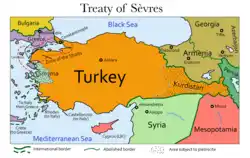
The Treaty of Lausanne was an agreement which was signed in the Swiss city of Lausanne on the 24th of July 1923. In essence it was the final major peace treaty of the First World War between one of the defeated Central Powers, in this case the Ottoman Empire, and the victorious Entente powers, though there were a number of major subsequent conflicts that had played out in Turkey and the Eastern Mediterranean between 1918 and 1923 that it also resolved. The treaty was a victory for the emergent Republic of Turkey in that it guaranteed it far more land than the British, French, Greeks, Italians, Serbs and Romanians had earlier envisaged. Significant additional clauses within the treaty had huge implications for migration and settlement patterns around the Eastern Mediterranean, Levant and Caucasus as various neighbors of Turkey engaged in population transfers with it in order to create more religious and ethnically homogenous states. The foremost of these transfers was between Greece and Turkey, an action which saw some two million people uprooted in the course of the mid-to-late 1920s.[1]
Research your ancestors on MyHeritage
Treaty of Lausanne chronology of eventsTreaty of Lausanne chronology of events
The Treaty of Lausanne was the death knell of the Ottoman Empire, a Muslim empire which had once ruled a vast state stretching from Algeria to parts of Persia and from Hungary to Yemen. It entered a period of pronounced decline in the eighteenth century and began losing lands precipitously in the nineteenth and early twentieth centuries, most notably in the Balkans to Greek, Serb, Romanian, Bulgarian and Albanian independence movements, but also to resurgent Arab and Kurdish nationalists in the Middle East. Parts of the latter territories were nominally still controlled by the Turks in the early 1910s, but Ottoman rule was very tenuous here all the same.[2] For the government in Constantinople/Istanbul, then, the outbreak of the First World War in the summer of 1914 seemed to present an opportunity to revitalize their state and reacquire lost lands. Therefore, they quickly allied with Germany and joined the Central Powers along with the Austro-Hungarian Empire.[3]

The war did not go well for the Ottomans. Other than the self-inflicted wound which the British caused to themselves through the disastrous Gallipoli Campaign of 1915, the Turks suffered defeats in most places, most embarrassingly in western Arabia and the Levant, where poorly equipped Arab rebels aided by British advisors such as T. E. Lawrence began conquering the region. By the time the main war came to an end in 1918 Turkey’s problems extended beyond conflict with the British and her allies. Now it was facing an internal civil war as progressives became determined to bring the Ottoman sultanate to an end and replace it with a new Turkish republic. The leaders of this movement, like Mustafa Kemal Pasha, later known as Atatürk, would have to do so while also being invaded by various powers that were determined to seize more Turkish land, principally Greece, but also Italy, Britain and France, while Kurdish and Armenian separatists were also active in the east of the country.[4]
The resulting Turkish War of Independence lasted for four years. At first it seemed as though the Turks would be comprehensively defeated and reduced to a rump state, with Greece intent on acquiring large parts of Smyrna in western Anatolia and plans for a Kurdish state in the east and a large Armenian state that would extend westwards to include Trebizond. However, the Turks rallied in 1921 and 1922 and succeeded in pushing the Greeks out of central Turkey and back to the coast.[5] With these military gains Turkish negotiators at Lausanne were better placed to argue for maintaining the territorial integrity of Turkey. Hence, in the resulting treaty Armenia, which was falling under the influence of the nascent Soviet Union, did not receive the planned lands; Kurdish calls for their own state were ignored, in part because this also suited British interests in Mesopotamia; and the Greeks were confined to only receiving many of the Greek islands in the Aegean. The Turks retained control of all of mainland Anatolia right up to the Aegean coast.[6]
Extent of migration following the Treaty of LausanneExtent of migration following the Treaty of Lausanne
The negotiators at Lausanne were well aware that Greek claims to parts of the western coast of Turkey were grounded in historical ties to Greece. This part of the Eastern Mediterranean world had been colonized by the Greeks millennia earlier and many of the people here were both ethnically Greek and adhered to Greek Orthodox Christianity. Similarly, there was a sizeable minority of Muslims living Greece after centuries of Ottoman rule there between the fifteenth and nineteenth centuries. Accordingly, a key provision of the treaty was that mass population transfers would be carried out to transplant the Greeks of Anatolia to Greece itself or the Greek islands, and to send Greece’s Muslims in the other direction. These population transfers would involve upwards of two million people, with approximately three-quarters of these moving from Turkey to Greece.[7]
Demographic impact of the Treaty of LausanneDemographic impact of the Treaty of Lausanne

The demographic impact of these population transfers was huge. They were clearly designed to create more homogenous religious and ethnic states by removing non-Christians from Greece and transplanting the vast ethnically Greek, Orthodox Christian minority out of western Turkey. It should be noted that the Treaty of Lausanne was not the only step in this process, and population transfers of this kind had been carried out between the Ottoman Empire and numerous states in the Balkans in the nineteenth and early twentieth centuries. But Lausanne was the most comprehensive agreement of this kind between Greece and Turkey. In essence it largely reversed over three millennia of Greek settlement on the western coast of Turkey. Thus, many people in Greece today or indeed in Turkey will be able to trace an ancestor to the other country, ones who moved as a result of the terms of the Treaty of Lausanne in the 1920s. Remnants of all of this can still be seen in the Turkish landscape today, with the ruins of ghost towns like Kayaköy (Livisi) that were abandoned in the 1920s after their Greek inhabitants left still visible there today.[8]
See alsoSee also
Explore more about the Treaty of LausanneExplore more about the Treaty of Lausanne
- The Treaty of Lausanne at The Lausanne Project
- Greece, Asia Minor Refugees, 1914-1923 record collection on MyHeritage
- Greece’s Top 5 Types of Genealogy Records at Legacy Family Tree Webinars
- Turkey-Greece population exchange still painful for those yearning for a lost past at Middle East Eye
References
- ↑ https://thelausanneproject.com/history-lausanne-treaty/
- ↑ https://www.thecollector.com/decline-of-the-ottoman-empire/
- ↑ Mustafa Aksakal, The Ottoman Road to War in 1914: The Ottoman Empire and the First World War (Cambridge, 2008).
- ↑ https://www.history.com/topics/middle-east/ottoman-empire
- ↑ Peter Kincaid Jensen, ‘The Greco-Turkish War, 1920-1922’, in International Journal of Middle East Studies, Vol. 10, No. 4 (Nov., 1979), pp. 553–565.
- ↑ https://thelausanneproject.com/history-lausanne-treaty/
- ↑ https://merip.org/2013/06/the-greek-turkish-population-exchange/
- ↑ https://www.ekathimerini.com/society/163551/journey-to-livissi-a-greek-village-on-sale-in-asia-minor/

